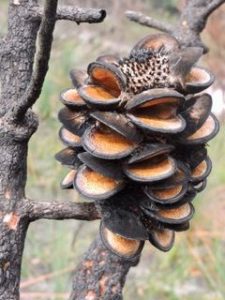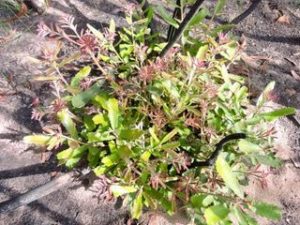After the damage from our bushfire season to many properties throughout NSW, homeowners are thinking about replanting their gardens, often while waiting for longer-term building works. The APS NSW office received an inquiry about advice on fire-resistant plants for people buying plants to restore gardens which had burnt.

Firstly, it is important to recognise that no plant is fire-resistant in extreme conditions and it takes more than fire-resistant plants to protect a garden. There are several elements to consider in reducing the risk of fire to and from a native garden.
1. Designing the garden
Before thinking about particular plants, it is important to consider the overall garden design, such as the distance of plant material from buildings, the heights of plants particularly trees, the location of paths and open spaces, the location of wood heaps and compost areas, and the location of fire-fighting resources such as pools, tanks, pumps and hoses.
Neighbouring gardens or distance to bushland may also affect garden design, and how a garden is affected by fire.
2. Choosing plants
Traditional advice on fire-resistant plants is to choose plants with high moisture content in the leaves and low volatile oils, such as rainforest plants. However, even rainforest plants with large dark green glossy leaves will burn in extreme conditions, and did in the recent fires. With new fire conditions, our understanding of how plants respond to fire is also changing.
Choosing plants in a garden is a balance between trees, shrubs and groundcovers. Different types of fire, such as canopy fires and ground fires, spread in different ways.
A fire-retardant species native to one area may not be suitable for a garden in another location. For instance, Carpobrotus glaucescens, known as pigface, is a succulent coastal groundcover, but it may not thrive in a Blue Mountains garden.
Many councils in bushfire-prone areas provide advice to residents on reducing risk to life and property, including advice on local native plants. The same species may behave differently in fire depending on its location, and not all species in the same genus will behave the same way. Check what resources your local council has.
An example from the Blue Mountains Council is here:
APS Victoria has a comprehensive list by Neil Marriott of fire resistant and retardant plants here: https://apsvic.org.au/fire-resistant-and-retardant-plants/
3. Choosing plants for recovery
Just as in the bush, some native plants are better able to recover from fire than others or recover in different ways at different speeds. For instance, Banksia serrata has a lignotuber and will resprout from its base if all leaves are burnt, but Banksia ericifolia does not have a lignotuber and will die, but regrow from seeds in the soil. Depending on the ferocity of a fire, trees can reshoot from epicormic buds on their trunks. The temperature of a fire will also affect any seed bank in the soil, and could encourage germination in the right conditions or kill the seeds.
Grass trees can produce new leaves quickly to replace burnt leaves.

4. Choosing other garden materials
As well as plants, there are many other materials in a garden which can burn. To maximise fire-resistant materials, consider using stone, gravels or sand for mulch, and consider materials used for garden structures such as seats, decks, pergolas and shelters.
5. Maintaining the garden

Tips for maintaining a garden to reduce fire risk include:
- Prune vegetation.
- Remove dead material and build up of twigs and sticks in plants and on the ground.
- Clear mulch and debris.
Unfortunately some of these maintenance tips conflict with best practices to provide habitat for local wildlife, big and small, including mammals, birds, reptiles and insects. Rocks can also provide habitat.
Remember, no plant is fire-resistant, just like no house is fireproof.
If you have any more tips, suggestions or resources for fire-smart gardening with native plants, please email Rhonda Daniels at enewsletter@austplants.com.au
More information: Angus Stewart discussed Planning a more bushfire resilient garden in his Newsletter 61, July 2020, at Gardening with Angus here.
